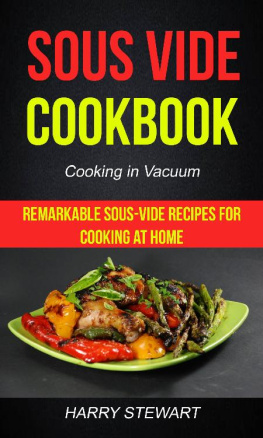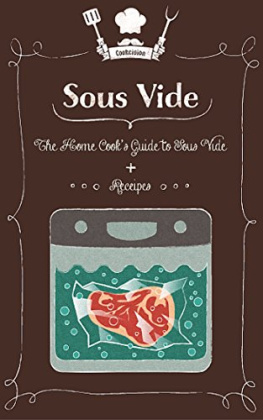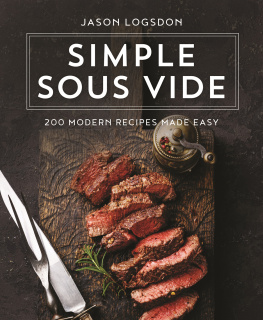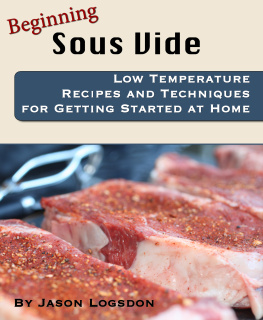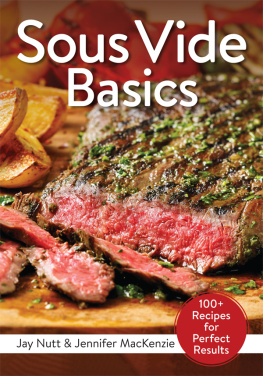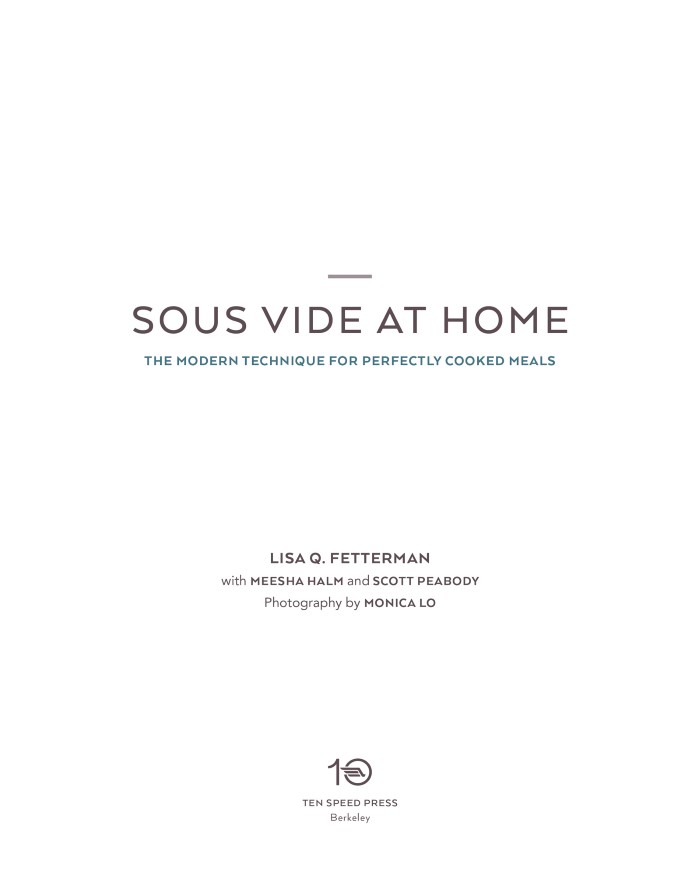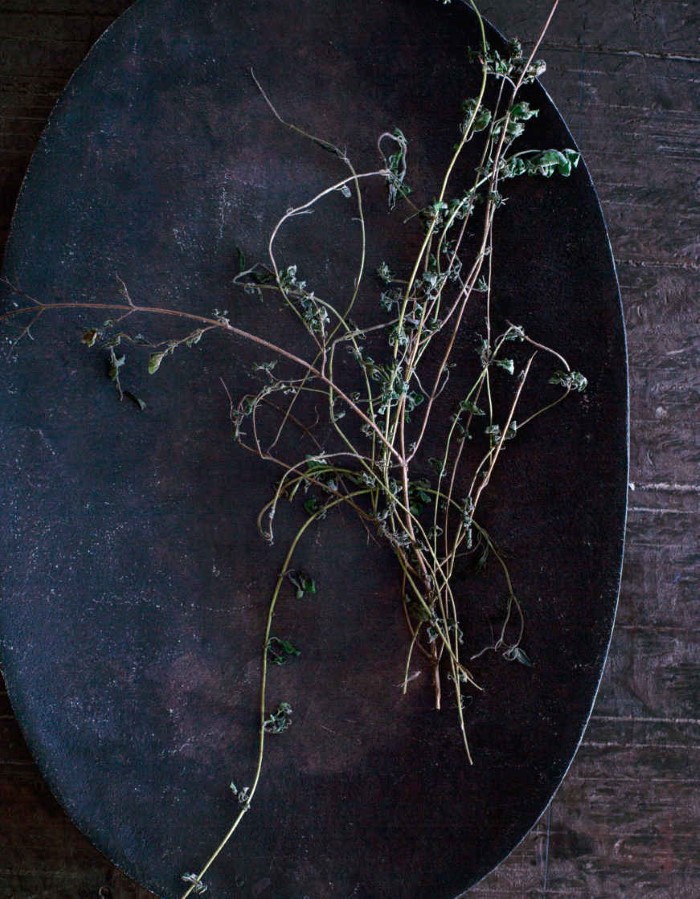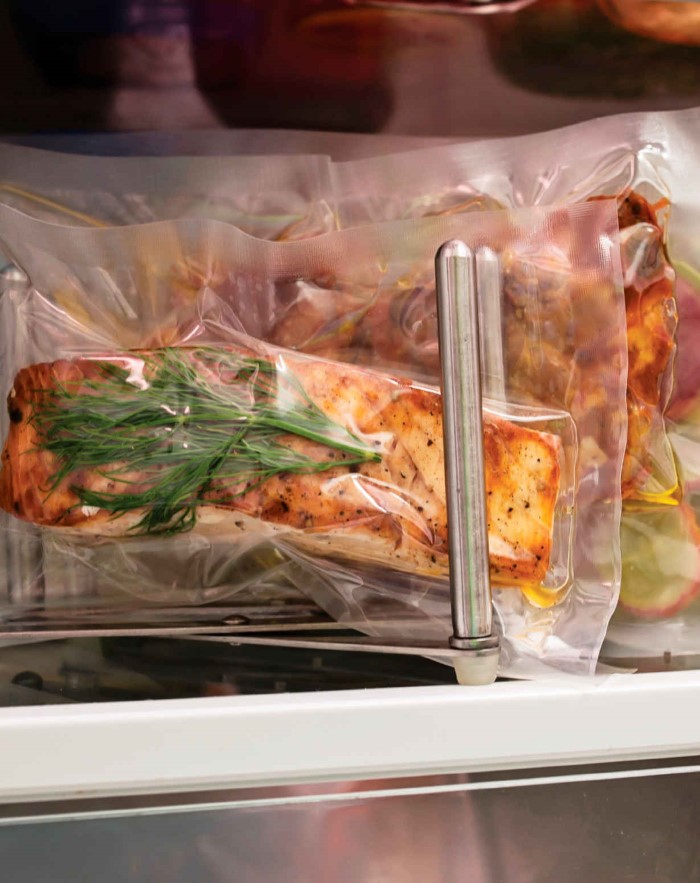Copyright 2016 by Lisa Q. Fetterman
Photographs copyright 2016 by Monica Lo
All rights reserved.
Published in the United States by Ten Speed Press, an imprint of the Crown Publishing
Group, a division of Penguin Random House LLC, New York.
www.crownpublishing.com
www.tenspeed.com
Ten Speed Press and the Ten Speed Press colophon are registered trademarks
of Penguin Random House LLC.
Library of Congress Cataloging-in-Publication Data
Names: Fetterman, Lisa Q., author. | Halm, Meesha, author. | Peabody, Scott, author.
Title: Sous vide at home the modern technique for perfectly cooked meals / by Lisa Q.
Fetterman with Meesha Halm and Scott Peabody ; photography by Monica Lo.
Description: First edition. | Berkeley, CA : Ten Speed Press, [2016] | Includes bibliographical
references and index.
Identifiers: LCCN 2016007211 (print) | LCCN 2016016632 (ebook)
Subjects: LCSH: Sous-vide cooking. | LCGFT: Cookbooks.
Classification: LCC TX690.7 .F48 2016 (print) | LCC TX690.7 (ebook) | DDC 641.5/87dc23
LC record available at https://lccn.loc.gov/2016007211
Hardcover ISBN9780399578069
Ebook ISBN9780399578076
v4.1
prh
Contents
Foreword by Dominique Crenn
COOKING IS AN ANCIENT ART that connects us with our deepest roots. But it is also a modern art that is constantly reinventing itself with new ideas, new materials, and new tools. When sous vide cooking first swept through the food world, some observers regarded it with suspicion, judging it too scientific to be absorbed into the art of cooking. It quickly prompted labels like molecular gastronomy, which proved intimidating. I prefer the term modernist cuisine because it implies the opening up of new avenues to the art of cooking.
Eventually, sous vide found its place in haute cuisine, just as the visual arts made room for photography alongside painting and drawing. But an artistic evolution is not complete until it becomes widely available to the public. And thats why I love Nomiku, one of the first devices to make sous vide cooking at home possible. Its like the little Nikon camera that brought photography out of the studio and into the hands of the people. Nomiku democratizes sous vide, creating an outlet for personal expression.
Its not just the technology, however. Its the people who make Nomiku such a creative force. I remember when I first met Lisa Fetterman. A dynamo fueled by energy and enthusiasm, she was passionate about her Nomiku. I mean, she simply would not rest until I tried her sous vide machine. Once I did, I had to admit it was great. Since then, Ive been using the Nomiku at my restaurants, Atelier Crenn and Petit Crenn, and I love it. I have four now.
For me, sous vide is all about texture and about getting consistent results. Nomiku gives its user an intuitive and reliable way to explore sous vide cooking without taking up a lot of space in the kitchen. Thats important not only for chefs but also for everyone who loves to cook. The versatility of this tool is continually inspiring. And ultimately, whether everyone is gathered around an open fire or around a Nomiku, cooking is about people, about connection.
I love the way that Nomiku encourages a community to engage in a dialogue that fosters experimentation. For me, thats what is most important: the opening up of an avenue for personal expression. This book is not only a collection of recipes and a guide to a new culinary mode but also an invitation to culinary improvisationan encouragement to try something new. We can all be artists in the kitchen. We just need the right tools.
Preface: Nomiku, A Love Story
I WAS SEVEN YEARS OLD when my family moved from China to America. It was hard for me to make friends at school because I didnt know English or even that I had to change my clothes every day. One day, I invited a classmate over for dinner. I desperately wanted her to like me, so I thought long and hard about what to serve that would impress her. I settled on a century egg, a traditional preserved Chinese duck egg with a striking jade-hued yolk surrounded by a translucent amber white. Since its prized as a delicacy, I figured it was cool. She took one bite, made a little bit of a face, and then sat silently during the rest of the meal. The next day, I was a worried about what the kids at school were going to say to me. As I walked onto the schoolyard, they began circling around me, and I braced myself for the onslaught of teasing. But to my amazement, they started chanting, Lisa, Lisa, Lisa. Can we come to your house and eat your weird food? That day internalized for me the power of food to connect us. Even when I didnt know how to behave, food broke through.
From then on, my world changed. I started to idolize the top chefs around the globe and to follow every New York City Michelin-starred restaurant in the media. Sometimes Id call the restaurants just to see how they answered their phone. I know, a bit stalker-y, right?
When I turned eighteen, I moved to Manhattan and started working in the restaurants of many of my heroes. I spent a year at Mario Batalis Babbo and then worked for Jean-Georges Vongerichten at his eponymous restaurant in Columbus Circle. After I got over being starstruck, I began to notice that purring away in the corner of every top kitchen was a hulking piece of laboratory-grade equipment outfitted with a pump that heated and circulated a giant water bath. Chefs would drop perfectly portioned bags of food into this gurgling beast and pull them out later to prepare their dishes.
I became intrigued by this mysterious contraption that made food that brought me to my knees. What on earth was this sous vide machine? I felt like I had been transported into the future for a moment and had seen what food could be. I wanted to tell everyone about this miraculous device that turned out exquisite, perfectly cooked food night after night during dinner service. I soon became obsessed with the idea of owning one for myself, fantasizing about all of the great recipes that I could make with it. I spent my evenings thinking about how I could fit one into my tiny Lower East Side apartment. (Maybe I could store it in my bathtub?) But I quickly became discouraged when I discovered that a machine cost thousands of dollars. With my grand hopes of culinary invincibility dashed, I resigned myself to the reality that sous vide machines were for professional chefs only, and reluctantly pushed my fantasy of owning one to the back of my mind.
Fast-forward a few years to when I started dating Abe (now my husband), a cute, lanky plasma physicist who I met at a yoga class. We were the only students who showed up, and we hit it off right away. He was as into the food scene as I was, but thats not where the chemistry stopped. A light bulb went off: as I gazed into his adorable saucer-shaped eyes, it dawned on me that a scientist who could create cold fusion at his day job could probably conquer any mechanical challenge.


